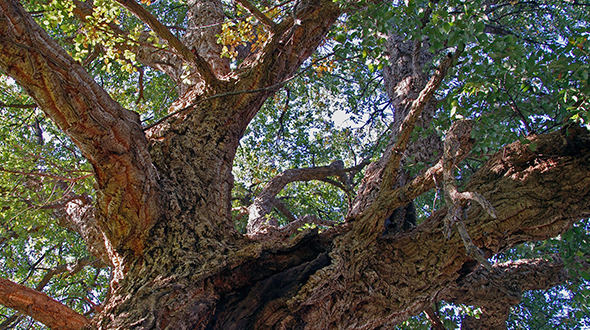
Need help deciding which trees with twisted trunks and branches to use as a specimen on your landscape? Knowing which tree species grow in a twisted form will help you determine which one to plant as a centerpiece on your beautiful landscape.
toddsmariettatreeservices.com gathered the following species and growing information for naturally twisty trees to consider for your landscape’s specimen tree.
What Causes a Twisted Tree?
Spiral or twisted patterns are clever tree survival adaptations. Since the bark and wood of trees do not grow in unison, the spiral pattern beneath the bark may not be evident until the bark drops from the tree.
Tree wood cells that must support heavy loads of massive branches and a dense crown, growing in an excessively windy location, or grow on unusually uneven land, like shore pines that grow in windy and sandy areas, can grow in a twisted pattern to provide more strength to the tree and its branches.
Environmental factors like prevailing winds, compromised roots, and physical barriers can cause trees to twist and adapt. A spiral wood grain efficiently and evenly delivers water and nutrients throughout the tree when straight grain wouldn’t be sufficient. Other common theories include the following:
- Tree genetics
- Heliotropism (tracking the sun)
- The Coriolis Effect (causing the clockwise wind pattern and ocean current in the northern hemisphere)
Regardless of why they twist, they are a sight to behold as they mature. Consider the following twisty tree species for your landscape needs:
Jack Pine (Pinus banksiana)

Jack pine needles typically grow in bundles of two, the tree’s cones are tightly wrapped and slightly curved, while the tree’s bark is thin and flaky on younger trees, maturing into thicker plates as they age. This species has crooked branching and trunk development when grown in open landscapes (rather than forested or crowded situations), giving it an oversized bonsai appearance.
USDA Hardiness Zones – 2 through 6
Mature Size – This tree reaches 40 to 50 feet with a spread of 15 to 20 feet
Lifespan – 80 to 100+ years
Scotch Pine (Pinus sylvestris)

The Scotch pine is a fast-growing, medium-sized evergreen conifer that typically grows with a conical to columnar (often irregular and contorted) habit and then develops an open, rounded irregular, or gnarled crown as it ages. Cones are small and rounded, while needles typically grow in twisted bunches of two.
USDA Hardiness Zones – 3 through 7
Mature Size – This tree reaches 30 to 60 feet with a spread of 30 to 40 feet
Lifespan – 150 to 300 years
Japanese Black Pine (Pinus thunbergii)

The Japanese black pine is an attractive evergreen conifer tree with a typically flat-topped pyramidal form with no prominent central leader. As this species ages, it grows irregular and asymmetrical, with drooping branches. The tree is noted for its shrubby habit and curved trunk.
USDA Hardiness Zones – 5 through 9
Mature Size – This tree reaches 20 to 60 feet with a spread of 10 to 20 feet
Lifespan – 15 to 20 years
Cork Oak (Quercus suber)

Unlike other oak trees, cork oak is a vibrant evergreen. The thick, gnarled dark grey bark is the portion known as “cork.” This tree can form a twisted trunk with sprawling branches.
USDA Hardiness Zones – 7 through 9
Mature Size – This tree reaches 30 to 65 feet with an equally sized spread
Lifespan – Over 200 years
Overcup Oak (Quercus lyrata)

Overcup oak is a medium-sized tree with an irregular crown and twisted branches. Native to North American east coastal plains, this tree’s often twisted growth reduces its value as a timber tree.
USDA Hardiness Zones – 5 through 9
Mature Size – This tree reaches 45 to 70 feet with a spread of 35 to 50 feet
Lifespan – 80 to 100+ years
Willow (Peppermint) Myrtle (Agonis flexuosa)

This species resembles a weeping willow (Salix babylonica) tree from a distance due to its long, drooping leaves. It is distinctive because of its powerful peppermint fragrance. This tree produces clusters of small white flowers, and its weeping branches partially conceal its twisted trunk.
USDA Hardiness Zones – 8b through 11
Mature Size – This tree reaches 10 to 15 feet with a spread of 8 to 10 feet
Lifespan – 50 to 80 years
Twisted Acacia (Acacia schaffneri)

Twisted Acacia is a spiny, spreading, multi-stemmed large shrub or small tree. The stems have many paired, pin-like spines and are pale to blackish. When young, a twisted Acacia needs aggressive pruning to maximize its gnarled trunk and branch growth.
USDA Hardiness Zones – 9 through 11
Mature Size – This tree reaches 20 to 25 feet with a spread of 25 to 30 feet
Lifespan – 30 years
Trees With Twisted Trunks
Some trees have a tendency for a “pronounced” twisted appearance where the trunk deviates from the species’ typical straight growth. Planting a tree that exhibits twisted trunk or branch growth adds curiosity and interest to a landscape and serves as a focal point or specimen tree. When choosing a tree species, select one that has this tendency. It is not guaranteed that an individual young tree will develop pronounced twists, but the result is worth the gamble.
Twisty Trees
In this article, you discovered species and growing information about several trees that grow with twisted trunks, branches, or both.
Knowing which tree species have twisting growth patterns will help you decide which to use as your landscape’s specimen tree.
Lack of info about twisted tree species may cause you to plant the wrong tree.
Sources:
wta.org/news/signpost/why-do-trees-grow-in-spirals
savetheredwoods.org/blog/forest/why-so-some-trees-grow-in-spirals/
nfs.unl.edu/woody-plants/jack-pine
plants.ces.ncsu.edu/plants/pinus-sylvestris/
uaex.uada.edu/yard-garden/resource-library/plant-week/Pinus-thunbergii-Japanese-Black-Pine-12-21-2017.aspx
sites.redlands.edu/trees/species-accounts/cork-oak/
rangeplants.tamu.edu/plant/twisted-acacia-huisachillo/
selectree.calpoly.edu/tree-detail/agonis-flexuosa
Originally published on: https://www.toddsmariettatreeservices.com/twisty-trees-for-your-landscape-specimen/

No comments:
Post a Comment